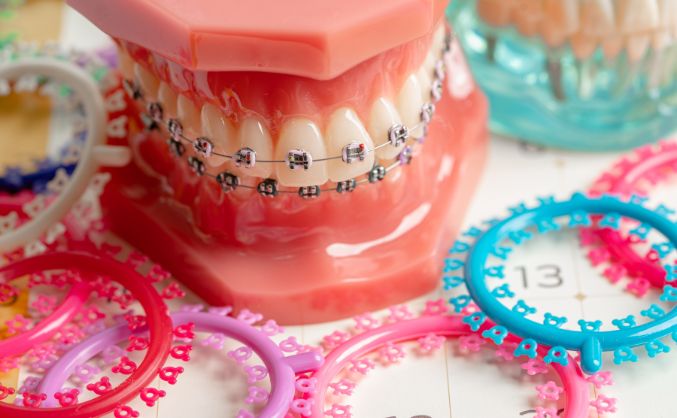Let’s focus on a question we get from many patients: How long do you have to wear braces? Unfortunately, there isn’t a one-size-fits-all answer. Generally, the length of treatment is about 18 to 24 months; however, the duration can vary based on individual needs.
In this blog post, we’ll shed light on the typical timeframe for braces and the key elements that influence it. By the end, you’ll have a clear understanding of what to expect on your journey to a straighter smile.
Factors Affecting Braces Wear Time
Several variables come into play when determining how long you’ll need braces. Here are some of the most significant ones:
1. The Severity of Your Misalignment
The complexity of your orthodontic case affects how long you need to wear braces. Minor issues like small gaps or slightly crooked teeth might only need braces for a year or less. On the other hand, more serious problems usually require a longer treatment time. For example, issues like impacted teeth, a deep bite, or significant crowding could take 1-3 years to treat.
2. The Type of Braces Used
The type of braces you choose can impact how long you need to wear them. Traditional metal braces, ceramic braces, and clear aligners each have different treatment times. Metal braces are often faster (12-24 months) because they are more durable and can apply more consistent pressure. Clear aligners might take longer, especially if you frequently remove them.
3. Your Age
Age can play a role in how quickly your teeth move. Generally, younger patients (children and teens) experience shorter treatment times because their jaws and teeth are still developing. Adults might need to wear braces longer since their bones are more rigid. However, modern orthodontics offers effective solutions for patients of all ages.
4. Compliance with Treatment
Orthodontic treatment is a two-way street. Adhering to your orthodontist’s guidelines will help you achieve the best results in the shortest time. Regularly scheduled appointments allow for necessary adjustments and ensure the braces are working correctly. Skipping appointments can delay your progress.
This list is not exhaustive — your orthodontist will be able to provide a more precise estimate of your wear time. Moreover, your orthodontist will conduct an examination, review X-rays, and discuss your goals while determining the most suitable treatment plan.
Additional Considerations Beyond Length of Time
While wear time is a factor, it’s not the only aspect to consider when embarking on your orthodontic journey. Here are some additional points to keep in mind:
1. Comfort and Adjustments
Braces can cause some initial discomfort, but this usually subsides as your teeth adjust. Regular adjustments are necessary to maintain pressure and keep your treatment progressing. Your orthodontist will discuss the frequency of these adjustments during your consultation.
2. Overall Oral Health
Maintaining good oral hygiene is paramount throughout your orthodontic treatment. Brushing and flossing around your braces is crucial to prevent cavities and gum disease.
3. Avoid Foods That Can Damage Braces
Certain foods can damage braces, leading to longer treatment times. Sticky, hard, or chewy foods can break brackets and wires, requiring additional orthodontic visits and adjustments. Try to embrace a braces-friendly diet to keep your treatment on track.
4. Retainers and Post-Braces Care
After your braces come off, you’ll likely need to wear a retainer for some time to maintain your new smile. Neglecting to wear a retainer can result in teeth shifting back to their original positions, undoing the progress you’ve made. In most cases, you’ll wear the retainers full-time initially, then gradually transition to nighttime use.
For a more detailed breakdown of the different types of braces available, visit the American Association of Orthodontists.

Contact Dr. Murray Orthodontics & Take the First Step to a Beautiful Smile
Are you ready to start your journey towards a straighter smile? Serving New Jersey and Pennsylvania, Dr. Murray Orthodontics offers comprehensive braces treatment. Schedule your appointment to get personalized care from experienced professionals. Let’s work together to achieve the smile you’ve always wanted.
FAQs
Can adults get braces?
Absolutely. Adults can benefit from braces just as much as teenagers. While treatment might take longer, modern orthodontic solutions are highly effective for patients of all ages.
Do braces hurt?
Wearing braces may cause some discomfort, especially after adjustments. The discomfort is usually mild and temporary. Over-the-counter pain relievers can help manage any soreness.
What can you eat with braces?
With braces, it’s best to avoid sticky, hard, and chewy foods that can damage the brackets and wires. Soft foods like yogurt, mashed potatoes, and smoothies are good options. Cutting food into smaller pieces can also help prevent damage.
How do you clean your teeth with braces?
Brush your teeth after every meal using a soft-bristled toothbrush and fluoride toothpaste. Flossing is also essential; special floss threaders can make it easier to clean between the braces.
How often should you visit the orthodontist while wearing braces?
Typically, appointments are every 4 to 6 weeks. Regular visits to the orthodontist are essential to monitor progress and make necessary adjustments.

